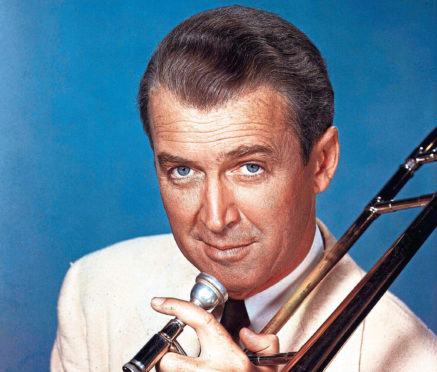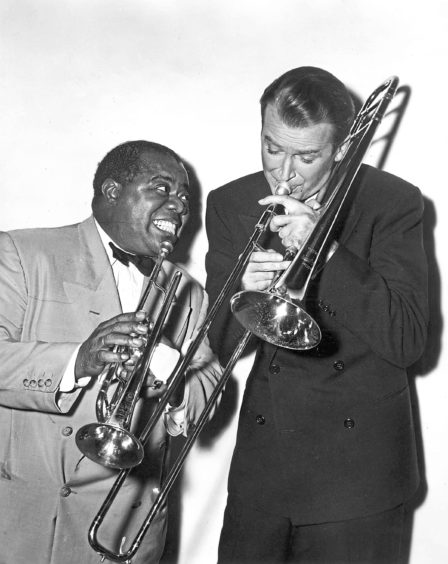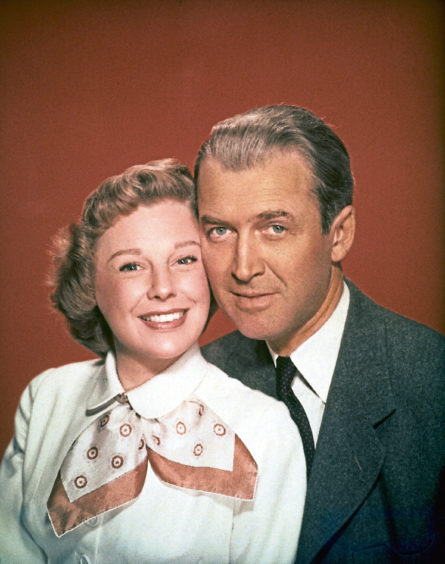
James Stewart was a superb and versatile actor – and, by all accounts, a thoroughly decent chap to boot.
But it turned out he was also one of Hollywood’s more financially-savvy stars.
Take The Glenn Miller Story, for example.
It was massively successful at the box office upon its release in 1954, taking in $7 million which, while way short of what a big-budget blockbuster would hope to rake in on its opening night alone, was huge for the time.
And smart Mr Stewart had negotiated a percentage of the profits from the biopic of the legendary big band leader and trombonist.
A year after the picture’s release, one studio executive estimated that the actor had earned a cool $2m from that one film alone.
The film was nominated for three Academy Awards including Best Screenplay and Best Score, winning the Oscar for Best Sound Recording.
Unsurprisingly, the soundtrack – featuring many of Miller’s most popular recordings – was as popular as the movie and reached No 1 on the Billboard album charts.
This was helped by the fact the soundtrack had a sheen of Glenn Miller magic in its production.
Glenn Miller Orchestra pianist John “Chummy” MacGregor was a technical advisor on the movie and none other than legendary Tinseltown composer Henry Mancini came up with the score.
The Orchestra itself was portrayed by The Airmen Of Note, a truly awfully-named ensemble of the United States Air Force Band created in 1950 to carry on the Glenn Miller tradition.
Stewart was an actor who liked to build relationships with his collaborators, and would make movies with the same people.
This was the second “non-Western” he made with director Anthony Mann with whom he’d had cowboy hits such as Winchester ’73, Bend Of The River, The Naked Spur and The Far Country.
However, this profitable friendship came to an end when the pair quarrelled over the casting of war hero Audie Murphy while in pre-production for 1957 “horse opera” Night Passage, and they never collaborated again.
However, one collaboration that didn’t end on a sour note was that between Stewart and June Allyson, who played Helen Miller.
This was the second of three movies in which the pair played husband and wife, the first being 1949 baseball biopic The Stratton Story and the final time coming in Strategic Air Command, a personal favourite of mine that drew upon wartime bomber pilot Stewart’s continued service in the USAF Reserve.
To be honest, this got me thinking – have any other actors played each other’s love interest as often?
Several pairs have partnered up twice but just one other on-screen couple have utilised their on-screen chemistry as often as Stewart and Allyson.
You’d probably have been able to guess that it’s none other than Tom Hanks and Meg Ryan who have sparkled alongside each other in Joe Versus The Volcano, and the classic Nora Ephron romcoms Sleepless In Seattle and You’ve Got Mail.
The biopic, originally called Moonlight Serenade after one of Glenn Miller’s hits, tells the story of the big band leader’s tragically short life between 1904 and 1944, when the plane carrying him over the Channel to entertain the troops in newly-liberated France vanished without trace.
Prominent is Miller’s courtship and marriage to Helen, and there are various cameos by actual musicians who were his colleagues including Louis Armstrong and The Modernaires who acted as his vocal group during the war years.
There are a few things in the picture that aren’t wholly accurate, such as marching troops being desegregated – which didn’t happen until 1948.
Also, there’s a scene in which Miller is dressed down by a superior officer for performing jazz marches, who tells him that more traditional Sousa marches served the military well during the First World War.
In the movie Stewart apologises sheepishly when in fact the more pugnacious Miller’s actual response was: “Are you still flying the same planes you flew in the last war?”
It’s surprising that this is the only time Miller has been played on screen as, with any mysterious event involving a celebrity, his disappearance is surrounded by conspiracy theories and you’d think they’d be meat and drink for film and TV execs.
One theory is that he was assassinated after Allied Supreme Commander Dwight D Eisenhower sent him on a secret mission to negotiate Nazi Germany’s surrender.
Another is that he was shot by a jumpy US military policeman in a Paris brothel, of all places, which was hushed up for morale purposes, while some claim his UC-64A Norseman aircraft was hit by bombs ditched by RAF Lancasters returning from an aborted raid.
Sadly, the much more prosaic truth is most likely that his plane came down in bad weather.
The Glenn Miller Story (1954), Sony Movies, Saturday April 4, 6.40pm.

Enjoy the convenience of having The Sunday Post delivered as a digital ePaper straight to your smartphone, tablet or computer.
Subscribe for only £5.49 a month and enjoy all the benefits of the printed paper as a digital replica.
Subscribe © Universal/Kobal/Shutterstock
© Universal/Kobal/Shutterstock © Universal/Kobal/Shutterstock
© Universal/Kobal/Shutterstock